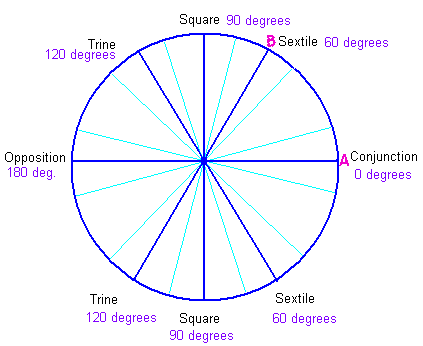Your Planetary Transits
What's a Transit? |
| Back to Contents |
An event consisting of two moving planets maintaining a particular aspect over a certain period of time is called a world transit ("world" because it is significant for everyone). If one planet is a planet in a natal chart, so that it is only the other planet which is moving, then we have a personal transit ("personal" because it depends on a natal chart and thus on a particular birth date/time).
 The maximum angle for which two planets are said to form an aspect is called an orb. Thus if the angle between two planets is 8° then they are conjunct with respect to an orb of 10°, but not with respect to an orb of 5°. Orb values are freely chosen, not determined, except that they are always more than 0° and normally never more than 15°.
The maximum angle for which two planets are said to form an aspect is called an orb. Thus if the angle between two planets is 8° then they are conjunct with respect to an orb of 10°, but not with respect to an orb of 5°. Orb values are freely chosen, not determined, except that they are always more than 0° and normally never more than 15°.
Consider two planets A and B which are initially exactly conjunct, and suppose that B moves faster than A, so that after a while B has moved 60° beyond A (anticlockwise from the '0 degrees' position in the diagram). The two planets then form an exact sextile aspect. But this sextile began earlier. Relative to an orb of 15° the sextile began when planet B first reached a position 45° beyond A, because 60°-15° = 45°. The sextile will persist until planet B reaches a position 75° beyond A, because 60°+15° = 75°. Relative to an orb of 10°, the sextile begins when B reaches a position 50° beyond A and it ends when B is 70° beyond A. Relative to an orb of 5°, the sextile begins when B reaches a position 55° beyond A and it ends when B is 65° beyond A.
The major aspects are: conjunction (0°), sextile (60°), square (90°), trine (120°) and opposition (180°). Planets (other than the Sun) can move backwards along the ecliptic (this is called retrograde motion), but ignoring this for the moment, planet B will form aspects successively with planet A in the following order: conjunction, sextile, square, trine, opposition, trine, square, sextile and back to conjunction. But because both planets (other than the Sun) may exhibit retrograde motion, the succession of aspects is often not as regular as this, and it may be quite complicated.
| Next: Input to the Program | |
| Your Planetary Transits | Home Page |